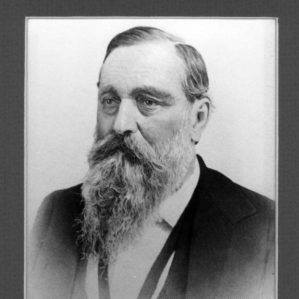By Fred O. Henker, M.D

How did Roscoe Jennings, born in Maine, get to be a surgeon in the Confederate Army?
Roscoe was born on a farm in Leeds, Maine on June 11, 1833. He attended the local school and because he was an assiduous scholar, was placed in charge of the school when he was 17.
At the age 18, when his father died, he had never been farther than 25 miles from home. Longing to see other states and how people lived, he borrowed $100 from his brother and set out with a friend. They traveled to Portland, Boston, and New York, but by then, money was almost gone. In Still Valley, Penn., he induced school trustees to employ him to teach during their four-month winter term. The pupils, a rough bunch referred to as “canal and New York wharf rats,” had thrown out all previous teachers. He won over all 100 students and made the school a success.
All the while he was teaching, he was determined to pursue a career in medicine. He returned to Maine and attended lectures at Dartmouth Medical College and graduated with honors in 1856 from the Medical School of Maine.
He decided then to “go west” and traveled to Albany, Buffalo, Detroit and Lapeer, Michigan, where he practiced in 1856-57. Next, he went to Chicago and visited a friend, Dr. A. S. Frye, with whom he had studied and attended lectures. Interested in the South, he went to Cairo, Ill., and boarded a Mississippi River steamboat for New Orleans. From there he traveled to Camden, Ark., where his eldest brother practiced law.
Dr. Jennings entered practice in Camden with Dr. Benjamin Jett. In 1860, he purchased Dr. Jett’s drugstore and ran it along with his practice of medicine.
When the war began in 1861, he entered the Confederate Army as Surgeon of the 12th Arkansas Regiment, to which he had been appointed and commissioned. The group organized in Arkadelphia, Ark., then moved through Little Rock to the front. Dr. Jennings was so impressed with Little Rock as they marched through, he wrote his brother of plans to make his future home there.
The regiment camped at Memphis through October 1861. As 950 of the 1100 men contracted measles, Surgeon Jennings was busy. After spending the winter camped in New Madrid, Ark., he was ordered to proceed to Vicksburg and establish Confederate hospitals there.
Surgeon Jennings’ regiment was captured April 7, 1862, but he escaped and finally made his way back to Memphis where he found a remnant of the unit. Later he developed camp fever and was given indefinite sick leave. After a long recuperation, part spent in Washington, Ark., he returned to Jackson, Miss.
In 1864, he became weak with acute rheumatism and had to resign his commission. In this condition, Dr. Jennings set out for Little Rock. When he arrived after his long, arduous trek, his clothes were rags and he had no money. Friends secured him the position of assistant surgeon in the federal garrison at Fort Steele, now the site of Philander Smith College. In 1865, he was ordered to take charge of the smallpox hospital there and became expert in the treatment of that disease.
In April 1869, Dr. Jennings was married to Gertrude Elliott of Camden on the porch of the Arsenal Building in Little Rock Barracks, now MacArthur Museum of Arkansas Military History. Their children were Octavia, Orville and Elliott Crews Jennings.
Physically strong and articulate in speech, Dr. Jennings was appointed Surgeon General of Arkansas troops in the 1874 Brooks-Baxter War. In 1879, he joined Dr. P. O. Hooper and six other physicians in founding the School of Medicine of Arkansas Industrial University, now the University of Arkansas for Medical Sciences. He was a professor of clinical surgery and venereal diseases and served as secretary of the medical school. He was active in local and state medical societies and was a member of the American Medical Association since 1869.
Dr. Jennings also maintained a private practice from his home at 6th and Arch Streets. His last professional call was made to the home of ex-Governor Henry Rector to attend Governor Rector’s wife in her last hours. From that call he went home feeling ill and died a few days later of pneumonia on April 5, 1899. His body was sent to St. Louis for cremation in accordance with his wishes. Entombment followed in Mount Holly Cemetery.
